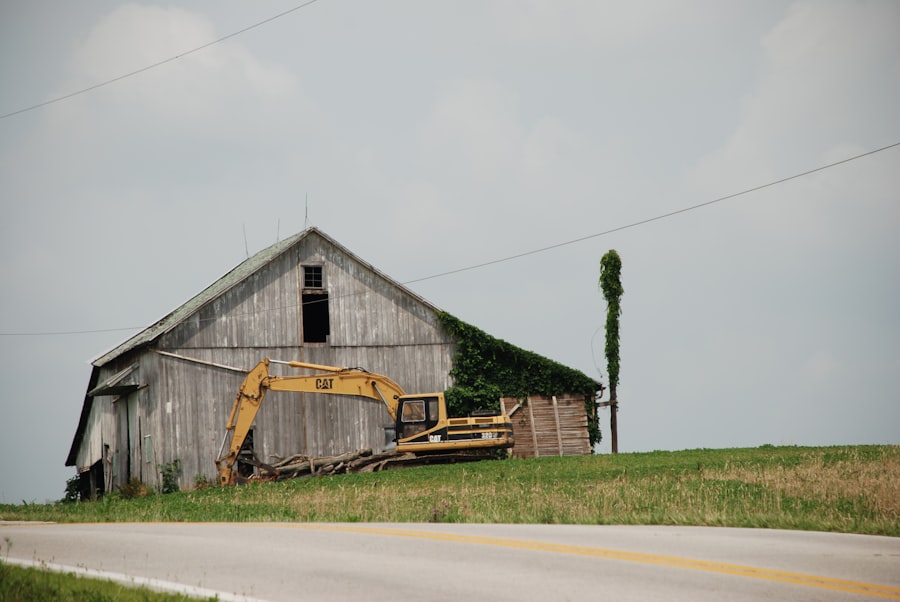The decline of rural economies has become a pressing issue in many parts of the world, particularly in developed nations. This phenomenon can be attributed to a multitude of factors, including the migration of young people to urban areas in search of better job opportunities, the consolidation of agricultural operations, and the increasing reliance on technology that often overlooks rural needs. As industries shift towards automation and digitalization, rural communities find themselves at a disadvantage, struggling to keep pace with the rapid changes that define modern economies.
The result is a cycle of economic stagnation, where diminished job prospects lead to population decline, further exacerbating the challenges faced by these regions. Moreover, the decline of rural economies is not merely an economic issue; it also has profound social implications. As populations dwindle, essential services such as healthcare, education, and public transportation become less viable, leading to a further exodus of residents.
This creates a feedback loop that can be difficult to break. Communities that once thrived on agriculture and local businesses now face empty storefronts and abandoned homes, which can lead to a loss of cultural identity and community cohesion. Understanding these dynamics is crucial for developing effective strategies to revitalize rural economies and ensure their sustainability in the future.
Key Takeaways
- Rural economies are declining due to factors such as outmigration, lack of infrastructure, and limited access to education and healthcare.
- Investing in infrastructure and technology is crucial for revitalizing rural economies and improving connectivity to urban centers.
- Supporting small business development can create job opportunities and stimulate economic growth in rural areas.
- Encouraging entrepreneurship and innovation can lead to the creation of new industries and services in rural communities.
- Diversifying agricultural practices can help rural economies become more resilient to market fluctuations and climate change.
Investing in Infrastructure and Technology
To combat the decline of rural economies, significant investment in infrastructure and technology is essential. Improved infrastructure—such as roads, bridges, and internet connectivity—can facilitate access to markets and resources, making it easier for rural businesses to thrive. High-speed internet, in particular, has become a lifeline for many rural communities, enabling them to participate in the digital economy.
By investing in broadband expansion, rural areas can attract new businesses and retain existing ones, fostering an environment conducive to growth and innovation. In addition to physical infrastructure, technological advancements can play a pivotal role in revitalizing rural economies. The adoption of smart farming techniques, for instance, can enhance agricultural productivity while minimizing environmental impact.
Precision agriculture technologies allow farmers to optimize their operations through data-driven insights, leading to increased yields and reduced costs. Furthermore, technology can facilitate remote work opportunities, allowing residents to engage in employment without having to relocate to urban centers. By embracing technology and investing in infrastructure, rural communities can create a more resilient economic landscape that is better equipped to face future challenges.
Supporting Small Business Development

Small businesses are often the backbone of rural economies, providing essential goods and services while creating jobs for local residents. Supporting small business development is therefore critical for revitalizing these areas. This support can take various forms, including access to financing, mentorship programs, and training initiatives that equip entrepreneurs with the skills they need to succeed.
Local governments and organizations can play a vital role in fostering an environment where small businesses can flourish by offering grants or low-interest loans specifically designed for rural entrepreneurs. Moreover, creating networks among small businesses can enhance collaboration and resource sharing. By establishing business incubators or co-working spaces, rural entrepreneurs can benefit from shared knowledge and experiences while reducing overhead costs.
These collaborative environments can also stimulate innovation as business owners come together to brainstorm new ideas and solutions. By prioritizing small business development, rural communities can not only boost their local economies but also foster a sense of pride and ownership among residents.
Encouraging Entrepreneurship and Innovation
| Country | Entrepreneurship Index | Innovation Index |
|---|---|---|
| United States | 83.6 | 86.5 |
| United Kingdom | 78.3 | 79.8 |
| Germany | 76.9 | 81.2 |
| China | 72.4 | 74.6 |
Encouraging entrepreneurship and innovation is essential for revitalizing rural economies. By fostering a culture that values creativity and risk-taking, communities can inspire individuals to pursue their business ideas and contribute to local economic growth. This can be achieved through various initiatives, such as entrepreneurship training programs in schools or community centers that teach essential skills like business planning, marketing, and financial management.
Additionally, hosting pitch competitions or innovation fairs can provide aspiring entrepreneurs with platforms to showcase their ideas and connect with potential investors. Furthermore, collaboration between educational institutions and local businesses can enhance entrepreneurial ecosystems in rural areas. By partnering with universities or vocational schools, communities can create programs that align educational offerings with local industry needs.
This not only equips students with relevant skills but also encourages them to remain in their communities after graduation. By nurturing entrepreneurship and innovation, rural economies can diversify their economic base and create sustainable pathways for growth.
Diversifying Agricultural Practices
Agriculture has long been a cornerstone of rural economies; however, reliance on traditional farming practices can leave communities vulnerable to market fluctuations and environmental challenges. Diversifying agricultural practices is crucial for building resilience within these economies. This can involve introducing alternative crops or livestock that are better suited to changing climate conditions or exploring organic farming methods that cater to growing consumer demand for sustainable products.
By diversifying their agricultural output, farmers can reduce risk while tapping into new markets. Additionally, integrating value-added processing into agricultural operations can enhance profitability for rural producers. For instance, farmers can transform raw products into processed goods—such as jams, cheeses, or artisanal breads—thereby increasing their market value.
Establishing cooperatives or partnerships among farmers can facilitate this transition by pooling resources and sharing knowledge about best practices in value-added production. By embracing diversification in agriculture, rural communities can create more stable economic foundations while promoting sustainable practices that benefit both local economies and the environment.
Promoting Tourism and Cultural Heritage

Tourism presents a unique opportunity for rural economies to diversify their income sources while showcasing their cultural heritage. Many rural areas boast rich histories, stunning landscapes, and unique traditions that can attract visitors seeking authentic experiences away from urban centers. By promoting local attractions—such as historical sites, natural parks, or cultural festivals—communities can draw tourists who contribute to the local economy through spending on accommodations, dining, and activities.
Collaborating with local artisans and craftspeople to create unique products or experiences can further enrich the tourism offering. By leveraging their cultural heritage and natural beauty, rural communities can create sustainable tourism models that not only generate revenue but also foster pride in local traditions and history.
Improving Access to Education and Training
Access to quality education and training is fundamental for empowering individuals in rural communities and equipping them with the skills needed for today’s job market. Many rural areas face challenges related to educational resources, including limited access to advanced courses or vocational training programs. Addressing these gaps is essential for ensuring that residents have opportunities for personal and professional growth.
Initiatives such as mobile learning centers or partnerships with online educational platforms can help bridge these gaps by bringing resources directly to underserved areas. Furthermore, fostering lifelong learning opportunities is crucial for adapting to changing economic landscapes. Providing adult education programs or skills training workshops can enable individuals to reskill or upskill as industries evolve.
By prioritizing education and training access, rural communities can cultivate a workforce that is adaptable and prepared for the demands of the modern economy.
Strengthening Community Engagement and Collaboration
Community engagement is vital for revitalizing rural economies; when residents are actively involved in decision-making processes, they are more likely to invest in their community’s future. Strengthening collaboration among local stakeholders—including government officials, business owners, educators, and residents—can lead to more effective strategies for economic development. Regular town hall meetings or community forums provide platforms for dialogue where individuals can voice their concerns and contribute ideas for improvement.
Additionally, fostering partnerships between public and private sectors can enhance resource allocation and project implementation. Collaborative initiatives that address specific community needs—such as infrastructure improvements or workforce development programs—can yield significant benefits when stakeholders work together towards common goals.
Addressing Healthcare and Social Services
Access to healthcare and social services is a critical component of thriving rural economies; without adequate support systems in place, residents may struggle with health issues that hinder their ability to work or participate fully in their communities. Many rural areas face challenges related to healthcare access due to geographic isolation or limited resources. Addressing these disparities requires innovative solutions such as telehealth services that connect patients with healthcare providers remotely or mobile clinics that bring services directly into underserved areas.
Moreover, strengthening social services—such as mental health support or substance abuse programs—can enhance overall community well-being. By investing in comprehensive healthcare initiatives that prioritize prevention and accessibility, rural communities can improve residents’ quality of life while fostering a healthier workforce capable of contributing positively to the local economy.
Leveraging Natural Resources for Sustainable Development
Rural areas often possess abundant natural resources that can be harnessed for sustainable development. Whether it’s timber from forests, minerals from the earth, or renewable energy sources like wind or solar power, these resources present opportunities for economic growth when managed responsibly. Implementing sustainable practices ensures that natural resources are utilized without compromising future generations’ ability to benefit from them.
Additionally, promoting eco-tourism initiatives centered around natural resources can attract visitors while preserving the environment. By balancing economic development with environmental stewardship, rural communities can create sustainable pathways that benefit both local economies and ecosystems alike.
Advocating for Policy Changes and Government Support
Advocating for policy changes at local, state, and national levels is essential for addressing the challenges faced by rural economies effectively. Policymakers must recognize the unique needs of these communities and implement supportive measures that promote economic growth while ensuring equitable access to resources. This may include advocating for funding allocations specifically targeted at rural development projects or policies that incentivize businesses to invest in underserved areas.
Furthermore, engaging residents in advocacy efforts empowers them to take an active role in shaping their community’s future. Grassroots movements focused on economic revitalization can amplify voices that may otherwise go unheard in policy discussions. By working together to advocate for meaningful change, rural communities can secure the support they need to thrive in an increasingly competitive landscape.
In conclusion, revitalizing rural economies requires a multifaceted approach that addresses various interconnected challenges while leveraging existing strengths within these communities. Through strategic investments in infrastructure and technology, support for small businesses and entrepreneurship, diversification of agricultural practices, promotion of tourism and cultural heritage, improved access to education and healthcare services, community engagement initiatives, sustainable resource management practices, and advocacy efforts at all levels of government—rural areas can pave the way toward a more prosperous future.
In addressing the challenges of rural economic decline, innovative solutions are essential to revitalize these communities and foster sustainable growth. One insightful article that delves into potential strategies is available on MyGeoQuest, which explores various approaches to stimulate economic development in rural areas. The article discusses the importance of leveraging local resources, enhancing digital connectivity, and promoting entrepreneurship as key drivers for economic revitalization. For a comprehensive understanding of these strategies, you can read the full article by visiting
